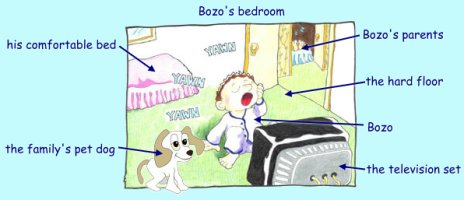| Who or what is involved? |
When we use language to talk about 'what is going on', we need to identify the people, animals, places and things that are involved.

We make sense of the world through language by naming and describing the things around us. We might, for example, want to talk about:
| a living thing (boy) | or | a non-living thing (television set) |
| a single thing (a yawn) | or | several things (yawns) |
| a specific thing (my bedroom) | or | a general category of things (bedrooms) |
| a named thing (Bozo) | or | an unnamed thing (a boy) |
| a concrete thing (door) | or | an abstract meaning (tiredness) |
| an everyday thing (pyjamas) | or | a technical thing (insomnia) |
| a real-life thing (the bed) | or | a fantasy thing (the harbour monster) |
We could refer to these as participants. In order to talk about
participants, we usually use nouns:
| Who? | What? | |
| Bozo noun |
was watching | television. noun |
We might want to give more detailed information about these participants:
what does it look like?
what shape is it?
what colour is it?
how big is it?
how many are there?
who owns it?
... and so on.
To provide more information about the participant, we can use a noun group:
| Who? | What? | |
| The tired boy noun |
ignored | his comfortable bed. noun |
Sometimes we use pronouns to refer to persons, animals, places and
things:
| Who? | What? | |
| He pronoun |
ignored | it. pronoun |
Different text types will focus on different types of participants. Stories,
for example, tend to focus on named, human participants and perhaps fantasy
characters. General descriptions tend to focus on more technical, generalised
participants. Arguments often involve abstract meanings, supported by concrete
evidence.
For further information on the process of naming and describing, click on the menu on the left: What is happening?: 'Naming and describing'
To find out more about identifying people, places and things, go to the following sections. (To return to this page, use the back button on your browser.)
Grammar |
|
|
Here you will find more information about identifying people, animals, places and things by using nouns, noun groups and pronouns.
|
|
Text types |
|
|
Here you will find examples of texts that focus on different types of people, places and things.
|
|
|
|
Teaching activities |
For PrimeTeach teaching activities which provide
KS2 students with practice in identifying people, places and things, see:
|
|
Tell me more ... Introduction |
|
||
To give us feedback about this section, click here or on the Comment button at the top of the screen.
If you have any questions about this section, visit the Language Corner.
If you have any questions or suggestions about how to teach this section, send a message to the Teaching Corner.